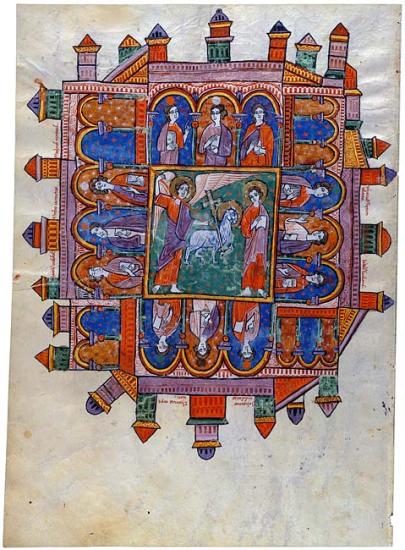
This is he that came by water and blood, even Jesus Christ; not by water only, but by water and blood. And it is the Spirit that beareth witness, because the Spirit is truth. For there are three that bear record in heaven, the Father, the Word, and the Holy Ghost: and these three are one. And there are three that bear witness in earth, the Spirit, and the water, and the blood: and these three agree in one.
The reference to the Trinity in the KJV, which I have placed in bold-faced type, does not appear in the CEB, or indeed in any modern English translation of 1 John. But that is not because of some conspiracy among Bible translators who do not believe in the Trinity! While this verse is included in Erasmus’ Textus receptus (“the received [and therefore presumably authoritative] text,” 1516), it is not found in the oldest and best texts of this book. Indeed, it does not appear in any Greek text of 1 John before the 14th century, and appears only in late texts of the Latin Vulgate (see the detailed discussion in A Textual Commentary on the New Testament, Bruce M. Metzger [London: United Bible Societies, 1975], 715-17). Simply put, this neat Trinitarian confession does not belong to 1 John, but rather reflects later Christian reflection on that text. Modern translators are right to exclude it.
Since we do not have the single, pristine, “original” text of ANY biblical book, New Testament or Old, responsible Bible scholars encounter this sort of problem all the time. For every passage of Scripture, we have multiple witnesses, among which we must choose. This study is called text criticism.
The best concise statement I know of why text criticism matters comes from Julia O’Brien: “Knowing what words are in the text is often as complex as understanding what those words mean” (The Oxford Handbook of the Minor Prophets, ed. Julia M. O’Brien [Oxford: University Press, 2021], xxii). Before deciding how best and most faithfully to render the Hebrew, Aramaic, or Greek text into clear and understandable English, we need first to determine what the best text is: which words to translate. 
For example, consider the climax of John’s vision of the world to come in Revelation 21. Here, the New Jerusalem is a massive golden cube, 1,500 miles long, wide, and high (Rev 21:16)! The most likely parallel for John’s image is the inner room of the temple, called the Most Holy Place: a perfect cube, with walls were covered in gold (1 Kgs 6:20; Ezek 41:4; see Craig Koester, Revelation, AB 38A [New Haven: Yale, 2014], 816] and Mathias Rissi, The Future of the World: An Exegetical Study of Revelation 19.11-22.15, Studies in Biblical Theology, Second Series 23 [Napierville, IL: Allenson, 1972], 62-63). John tells us, “I didn’t see a temple in the city, because its temple is the Lord God Almighty and the Lamb” (Rev 21:22). But indeed, the entire city is the holy dwelling place of God, where all God’s people are invited to live.
As in Ezekiel’s vision of the ideal city, John’s new Jerusalem has twelve gates, named with the names of the twelve tribes of Israel (see Ezek 48:30-35). But in John’s vision, these gates are never shut (Rev 21:25)–which, since the whole reason for gates is to control access to the city, subverts their purpose entirely! The light of God’s glory streams its invitation out of the open gates into the world outside, and John says, “The nations will walk by its light, and the kings of the earth will bring their glory into it. . . . People will bring into it the glory and the honor of the nations” (Rev 21:24-26, emphasis mine). Who are these people, outside the city, but now invited to enter it? As the nations and their kings have just been thrown into the lake of fire (Rev 20:11-15), what are we to make of this extraordinary claim?
If you read this passage in the KJV, that question never emerges. There, Revelation 21:24 reads “And the nations of them which are saved shall walk in the light of it” (emphasis mine).  As with 1 John 5:7, this translation is not based on any ancient Greek text of Revelation, but on Erasmus’ sixteenth-century Textus receptus. Erasmus inserts ton sozomenon (“the ones who are saved”) after ta ethne (“the nations”) in Revelation 21:24. Neither the Latin Vulgate nor the majority Byzantine Greek text have this addition. Nestle-Aland’s critical edition of the Greek New Testament Novum Testamentum Graece doesn’t mention this insertion, even as a minor variant to be considered, and Metzger’s Textual Commentary doesn’t even discuss it.
As with 1 John 5:7, this translation is not based on any ancient Greek text of Revelation, but on Erasmus’ sixteenth-century Textus receptus. Erasmus inserts ton sozomenon (“the ones who are saved”) after ta ethne (“the nations”) in Revelation 21:24. Neither the Latin Vulgate nor the majority Byzantine Greek text have this addition. Nestle-Aland’s critical edition of the Greek New Testament Novum Testamentum Graece doesn’t mention this insertion, even as a minor variant to be considered, and Metzger’s Textual Commentary doesn’t even discuss it.
So why did Erasmus add these words to the text of Revelation? Likely because he believed that John must have intended something like this. Otherwise Revelation 21:24 contradicts the last chapter regarding the fate of the nations. Erasmus may have been right to resolve this conflict–but what if he wasn’t? What if the text actually is contradictory, and ambiguous? The evidence of the best text of Revelation forces us to confront that apparent contradiction, and ask what it may mean. What if, in the end, God in God’s sovereign freedom includes even those once thought excluded?  So, what does text criticism mean to Bible students who do not know the original languages, and so lack access to the many texts behind the text on the page? First, the King James should not be your go-to study Bible. The language of the King James is beautiful and poetic: more often than not, the passages I have committed to memory are from its pages! For its day, the King James was an excellent translation. However, quite apart from the fact that we no longer speak in King James English, the translators in 1611 simply lacked access to the many ancient texts now available. Indeed, the oldest Hebrew manuscripts extant, the so-called Dead Sea Scrolls from Qumran, were unknown before the mid-twentieth century.
So, what does text criticism mean to Bible students who do not know the original languages, and so lack access to the many texts behind the text on the page? First, the King James should not be your go-to study Bible. The language of the King James is beautiful and poetic: more often than not, the passages I have committed to memory are from its pages! For its day, the King James was an excellent translation. However, quite apart from the fact that we no longer speak in King James English, the translators in 1611 simply lacked access to the many ancient texts now available. Indeed, the oldest Hebrew manuscripts extant, the so-called Dead Sea Scrolls from Qumran, were unknown before the mid-twentieth century.
So, what should be your go-to study Bible? I recommend the Common English Bible for ease of reading (it is my go-to reference for Bible quotes in this blog), and the New Revised Standard Version for serious study. Comparing multiple translations is a good policy–but only if we are careful not simply to select from among them the reading we like the best! Instead, ask why the translations differ? What could account for the choices the translators have made? Some guidance to answering that question may come from the introduction in the front matter of your Bible, which discusses the translation team’s intentions and philosophy.
Any responsible translation will also include text notes on each page, marked like footnotes. For example, on 1 John 5:7, a text note in the NRSV reads, “Other ancient authorities read (with variations) There are three that testify in heaven, the Father, the Word, and the Holy Spirit, and these three are one. And there are three that testify on earth:”. In the NIV, the note is more detailed: ” Late manuscripts of the Vulgate testify in heaven: the Father, the Word and the Holy Spirit, and these three are one. 8 And there are three that testify on earth: the (not found in any Greek manuscript before the fourteenth century).” Always make certain to check the text notes, to see what other options the translators had to consider. I should note, by the way, that neither the NRSV, the NIV, nor the CEB has a text note on Rev 21:24, but that in itself tells us something: none of these teams of translators believed the added words in the KJV to be worthy of comment.
Finally, a good study Bible, with detailed footnotes, will discuss in greater depth the issues involved, including text-critical questions. I recommend the HarperCollins Study Bible, prepared under the auspices of the Society of Biblical Literature. This edition of the NRSV has lots of maps, charts, and other helps, but the best parts are the extended introduction to each book of the Bible, and the footnotes: a third or more of every page, providing cross-references, further information pertaining to the history back of the text, and in many cases, additional insight into the translation. In some cases, the author of the introduction and notes on a book is the person primarily responsible for the translation of that book in the NRSV (for example, my late mentor S. Dean McBride in Deuteronomy), so that you can get straight from the horse’s mouth the reasons behind the choices made.
Determining, in O’Brien’s words, “what words are in the text” requires expert knowledge–and even experts may disagree as to their resolution. However, every reader of Scripture needs to be aware that these issues exist. Believers come to the Bible in order to hear God’s Word for us. But in order to hear the Word in Scripture, we must first be clear on the words of Scripture.
AFTERWORD:
For my jiffy summary evaluation of a number of Bible translations and paraphrases, enter “Which Bible?” in the search window above, or follow these links: “Which Bible?“; “Which Bible? Part Two“; “Which Bible? Part Three“; “Which Bible? Part Four.”